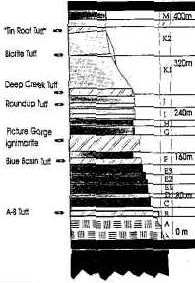|
John Day Fossil Beds
Major Turtle Cove Member (John Day Formation) |

|
JOHN DAY FORMATION
Rock Units C - F / Turtle Cove Member / John Day Formation at Foree

(view from the Flood of Fire Trail at the
Foree Picnic Area in the Sheep Rock Unit)
Units A-M, Turtle Cove Member, John Day Formation
 |
Scientific fossil collecting involves recording precisely what layer each specimen is found in. This requires detailed work in stratigraphy, the measurement and description of rock units within a geologic formation. Field notes taken by paleontologists working at John Day Fossil Beds indicate which rock unit each fossil is collected from. Fossils are almost always found in sedimentary rocks which form gradually over time as sediments accumulate and become cemented. Changes in sediment or patterns of deposition create natural boundaries between rock units. |
|
GLOSSARY |
Dateable Layers Volcanic layers that have been dated in the Turtle Cove section include:
|
turtlecove.htm
Last Updated: 09-Jan-2000